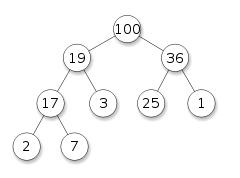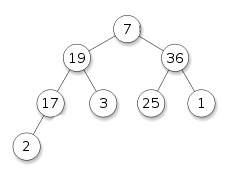In past couple articles I’ve introduced you to three basic data structures: stack, queue, and tree. In this article I’ll introduce you to another abstract data type that is closely related: heap. Heaps are specialized tree-like data structures which satisfy the heap property – the node value (key) of any parent is always ordered with respect to its child node values across the entire tree. Let’s take a closer look!
Key Takeaways
- Heaps are specialized tree-like data structures where the node value of any parent is always ordered with respect to its child node values across the entire tree. There are several heap variants including maxheap, minheap and a specialized data type called a Priority Queue.
- Heaps are usually implemented as complete binary trees, but unlike binary trees, there is no implied ordering of siblings and cousins, nor is there any implied sequence for an in-order traversal. They have operations like create, isEmpty, insert, and extract.
- Implementing a heap as an array is possible. A binary node has at most two children, therefore for any n number of nodes a binary heap will have at most 2n + 1 nodes. The insertion strategy is the exact opposite of extraction.
- PHP provides classes like SplHeap, SplMaxHeap, SplMinHeap and SplPriorityQueue to handle heaps. The Priority Queue is a specialized abstract data type that behaves like a queue, but is usually implemented as a heap. It has many real-world applications, such as service desks/ticket escalation and improving the performance of certain graph applications.
Heaps
There are several heap variants. For instance, if parent keys are ordered such that they are of equal or greater value than their children, and the highest key is at the root, the heap is said to be a maxheap. If parent keys are ordered such that they are of equal or lower value than their children, with the lowest key at the root, the heap is called a minheap. SPL (PHP>=5.3.0) provides a basic heap, minheap, maxheap, and a specialized data type called a Priority Queue.
So here’s an example of what a heap looks like:

The figure above depicts a complete binary maxheap. It’s binary because each node has exactly two children, and a maxheap because the highest value key is at the root node and all parent nodes have values greater than their children.
While heaps are usually implemented as complete binary trees, unlike binary trees there is no implied ordering of siblings and cousins, nor is there any implied sequence for an in-order traversal.
Heaps are a variant of the table data type so they also have the same basic operations:
- create – create an empty heap.
- isEmpty – determine if the heap is empty.
- insert – add an item to the heap.
- extract – remove the topmost item (root) item from the heap.
Unlike a table, the retrieve and delete operations for a heap are combined into a single extract operation, so let’s focus on how the extract operation works first.
The condition for removing an item from the heap is that we can only remove the root node. Let’s say we removed the root node (100) from the above example. We would be left with two disjoint heaps. We need a method of transforming the remaining nodes back into a single heap after the root is removed. Joining them is easily accomplished by moving the last node to the root, but we’re left with a resulting structure that fails the heap property. Such a structure is called a semiheap.

We now need a way to transform the semiheap into a heap. One strategy is to trickle the root item down the tree until it reaches a node where it will not be out of place. We iteratively compare the value of the root node to its children and swap places with the larger child until it arrives at a node where no child has a greater (or equal) value than itself.
Implementing a Heap as an Array
We can naively implement a binary maxheap as an array. A binary bode has at most two children, therefore for any n number of nodes a binary heap will have at most 2n + 1 nodes.
Here’s what an implementation looks like:
<?php
class BinaryHeap
{
protected $heap;
public function __construct() {
$this->heap = array();
}
public function isEmpty() {
return empty($this->heap);
}
public function count() {
// returns the heapsize
return count($this->heap) - 1;
}
public function extract() {
if ($this->isEmpty()) {
throw new RunTimeException('Heap is empty');
}
// extract the root item
$root = array_shift($this->heap);
if (!$this->isEmpty()) {
// move last item into the root so the heap is
// no longer disjointed
$last = array_pop($this->heap);
array_unshift($this->heap, $last);
// transform semiheap to heap
$this->adjust(0);
}
return $root;
}
public function compare($item1, $item2) {
if ($item1 === $item2) {
return 0;
}
// reverse the comparison to change to a MinHeap!
return ($item1 > $item2 ? 1 : -1);
}
protected function isLeaf($node) {
// there will always be 2n + 1 nodes in the
// sub-heap
return ((2 * $node) + 1) > $this->count();
}
protected function adjust($root) {
// we've gone as far as we can down the tree if
// root is a leaf
if (!$this->isLeaf($root)) {
$left = (2 * $root) + 1; // left child
$right = (2 * $root) + 2; // right child
// if root is less than either of its children
$h = $this->heap;
if (
(isset($h[$left]) &&
$this->compare($h[$root], $h[$left]) < 0)
|| (isset($h[$right]) &&
$this->compare($h[$root], $h[$right]) < 0)
) {
// find the larger child
if (isset($h[$left]) && isset($h[$right])) {
$j = ($this->compare($h[$left], $h[$right]) >= 0)
? $left : $right;
}
else if (isset($h[$left])) {
$j = $left; // left child only
}
else {
$j = $right; // right child only
}
// swap places with root
list($this->heap[$root], $this->heap[$j]) =
array($this->heap[$j], $this->heap[$root]);
// recursively adjust semiheap rooted at new
// node j
$this->adjust($j);
}
}
}
}The insertion strategy is the exact opposite of extraction: we insert the item at the bottom of the heap and trickle it up to its correct location. Since we know that a complete binary tree with a full last level contains n/2 + 1 nodes, we can traverse the heap using a simple binary search.
public function insert($item) {
// insert new items at the bottom of the heap
$this->heap[] = $item;
// trickle up to the correct location
$place = $this->count();
$parent = floor($place / 2);
// while not at root and greater than parent
while (
$place > 0 && $this->compare(
$this->heap[$place], $this->heap[$parent]) >= 0
) {
// swap places
list($this->heap[$place], $this->heap[$parent]) =
array($this->heap[$parent], $this->heap[$place]);
$place = $parent;
$parent = floor($place / 2);
}
}So let’s see what happens when we insert a few items into the structure:
<?php
$heap = new BinaryHeap();
$heap->insert(19);
$heap->insert(36);
$heap->insert(54);
$heap->insert(100);
$heap->insert(17);
$heap->insert(3);
$heap->insert(25);
$heap->insert(1);
$heap->insert(67);
$heap->insert(2);
$heap->insert(7);If you dump the heap structure you’ll notice that the items aren’t in any particular order. In fact, it’s not even in the order we would expect:
Array
(
[0] => 100
[1] => 67
[2] => 54
[3] => 36
[4] => 19
[5] => 7
[6] => 25
[7] => 1
[8] => 17
[9] => 2
[10] => 3
)
However, if you extract the items, this is what you would get:
<?php
while (!$heap->isEmpty()) {
echo $heap->extract() . "n";
}100 67 54 36 25 19 17 7 3 2 1
SplMaxHeap and SplMinHeap
Fortunately for us, SplHeap, SplMaxHeap and SplMinHeap abstracts all of this for us. All we have to do is extend the base class and override the comparison method like so:
<?php
class MyHeap extends SplMaxHeap
{
public function compare($item1, $item2) {
return (int) $item1 - $item2;
}
}The compare method can perform any arbitrary comparison, as long as it returns – in the case of a SplMaxHeap – a positive integer if $item1 is greater than $item2, 0 if they are equal, or a negative integer otherwise. If extending SplMinHeap, it should instead return a positive integer if $item1 is less than $item2.
It’s not recommended to have multiple elements with the same value in a heap as they may end up in an arbitrary relative position.
SplPriorityQueue
The Priority Queue is a specialized abstract data type that behaves like a queue, but is usually implemented as a heap – in the case of SplPriorityQueue, as a maxheap. Prioritized queues have many real-world applications, such as service desks/ticket escalation. They are also essential in improving the performance of certain graph applications.
Like the SplHeap, you only have to override the base class and comparator method:
<?php
class PriQueue extends SplPriorityQueue
{
public function compare($p1, $p2) {
if ($p1 === $p2) return 0;
// in ascending order of priority, a lower value
// means higher priority
return ($p1 < $p2) ? 1 : -1;
}
}The main difference in a SplPriorityQueue is that the insert operation expects a priority value – which can be a mixed data type. The insert operation uses the priority to sift the element up the heap based on the returned result of your comparator.
For illustration purposes, let’s use integer priorities:
<?php
$pq = new PriQueue();
$pq->insert('A', 4);
$pq->insert('B', 3);
$pq->insert('C', 5);
$pq->insert('D', 8);
$pq->insert('E', 2);
$pq->insert('F', 7);
$pq->insert('G', 1);
$pq->insert('H', 6);
$pq->insert('I', 0);
while ($pq->valid()) {
print_r($pq->current());
echo "n";
$pq->next();
}I G E B A C H F D
Notice that our items are displayed in order of priority – highest to lowest (the lower the value, the higher the priority). You can reverse the priority order by changing the comparator to return a positive integer if $p1 is greater than $p2.
By default, only the element’s data is extracted. If you wanted to extract the priority values only, or both the data and priority, you can set the extract flag like this:
<?php
// extract just the priority
$pq->setExtractFlags(SplPriorityQueue::EXTR_PRIORITY);
// extract both data and priority (returns an associative
// array for each element)
$pq->setExtractFlags(SplPriorityQueue::EXTR_BOTH);Summary
I’ve introduced you to the heap abstract data type and showed you how items are inserted and extracted from a heap using a simple array implementation. We’ve also seen how the comparator is used in min and maxheaps, and how the Priority Queue operates. Stay tuned; in the next article I’ll discuss graphs!
Image via Fotolia
Frequently Asked Questions about Heap Data Structures in PHP
What is the main difference between a heap and other data structures in PHP?
A heap is a specialized tree-based data structure that satisfies the heap property. This property stipulates that if P is a parent node of C, then the key of P is either greater than or equal to (in a max heap) or less than or equal to (in a min heap) the key of C. This makes heaps particularly useful in applications where it’s important to quickly find the largest or smallest element. Other data structures like arrays, linked lists, or binary trees don’t have this property.
How does a heap maintain its structure in PHP?
In PHP, a heap maintains its structure through the use of the SPLHeap class. This class provides methods to compare nodes (compare), extract the top node (extract), insert a node (insert), and peek at the top node (top). These methods ensure that the heap property is maintained after each operation.
What are some practical applications of heaps in PHP?
Heaps are used in various applications where time complexity is a critical factor. They are used in implementing priority queues, which are used in graph algorithms like Dijkstra’s and Prim’s. Heaps are also used in sorting algorithms like heapsort. In PHP, heaps can be used to manage datasets where you need to frequently find and remove the highest or lowest value.
How does the SPLHeap class compare to other PHP classes for data structures?
The SPLHeap class is part of the Standard PHP Library (SPL), which provides a collection of interfaces and classes for various data structures. Compared to other classes like SPLFixedArray or SPLDoublyLinkedList, SPLHeap is specialized for creating and managing heaps. It provides methods specifically designed for maintaining the heap property.
How can I create a min heap in PHP?
To create a min heap in PHP, you can extend the SPLHeap class and override the compare method. The compare method should return a positive value if the first argument is smaller than the second, 0 if they are equal, and a negative value if the first is larger. This will ensure that the smallest element is always at the top of the heap.
How does heap sort work in PHP?
Heap sort in PHP involves building a max heap from the input data, then repeatedly removing the largest element from the heap and inserting it at the end of the sorted section of the array. This process continues until the heap is empty, resulting in a sorted array. The heap sort algorithm takes advantage of the heap’s ability to quickly extract the maximum element.
What is the time complexity of operations in a heap?
The time complexity of operations in a heap is efficient. Insertion, deletion, and extraction of the maximum element all occur in O(log n) time, where n is the number of elements in the heap. This makes heaps a practical choice for datasets where these operations are frequent.
How can I use a heap to implement a priority queue in PHP?
A priority queue can be implemented using a heap in PHP by storing elements along with their priorities in the heap. The compare method of the SPLHeap class should be overridden to compare the priorities of elements instead of the elements themselves. This will ensure that the element with the highest priority is always at the top of the heap.
Can I store any type of data in a heap?
Yes, a heap can store any type of data. However, the data must be comparable in some way, as the heap needs to be able to determine the order of elements. This is typically done by providing a compare function when extending the SPLHeap class.
How does a heap differ from a binary search tree?
While both heaps and binary search trees are tree-based data structures, they have different properties. In a binary search tree, the left child of a node is less than the node, and the right child is greater. In a heap, a parent node is either greater than or equal to (max heap) or less than or equal to (min heap) its children. This means that heaps can be used to quickly find the max or min element, while binary search trees are efficient for searching for any given element.
Ignatius Teo is a freelance PHP programmer and has been developing n-tier web applications since 1998. In his spare time he enjoys dabbling with Ruby, martial arts, and playing Urban Terror.
Published in
·automation·CMS & Frameworks·Development Environment·Miscellaneous·Patterns & Practices·PHP·February 11, 2015






